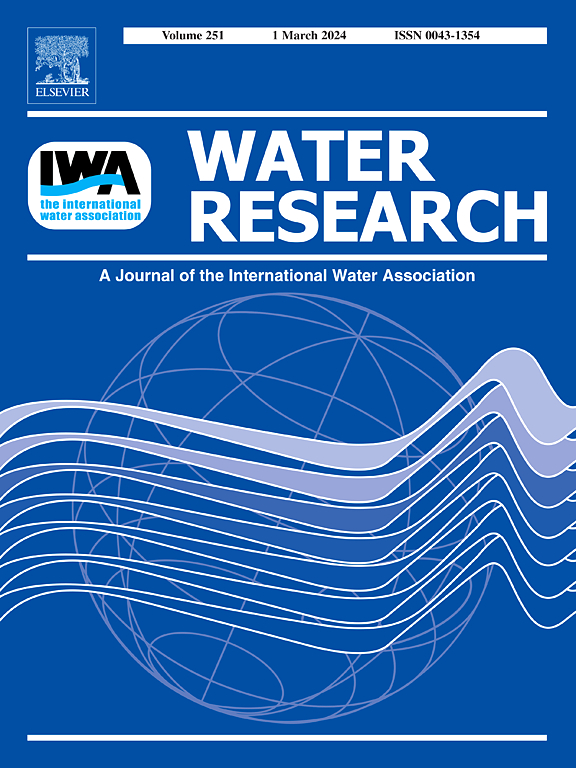Molecular imprinted Bi4O5Br2 nanosheets for visual ultrasensitive chlorophenols detection by developing a dye-photosensitization sensing system
IF 12.4
1区 环境科学与生态学
Q1 ENGINEERING, ENVIRONMENTAL
引用次数: 0
Abstract
The ultrasensitive, visual and intelligent identification of persistent chlorophenols (CPs) in complex drinking and environmental water matrices is highly desirable. In this study, we have established an interesting colorimetric dye eosin Y (EY)-molecular imprinted Bi4O5Br2 nanosheet photosensitization sensing system for CPs detection, in which the key is the rapid EY photosensitization decolorization to be efficiently inhibited in the presence of CPs. It displays an ultrasensitive detection of CPs, especially for the typical 2,4,6-trichlorophenol (TCP) across from 10 ng·L−1 to 1 mg·L−1, achieving a limit of detection of 7 ng·L−1 with remarkable selectivity. By means of in-situ Fourier transform infrared spectroscopy, time-resolved laser flash photolysis spectroscopy, and theoretical calculations, the outstanding performance is attributed to (i) the efficient transfer of triplet excited state electrons from EY to the ultrathin Bi4O5Br2 (∼4 nm) nanosheets through energy band alignment and (ii) enhanced TCP selective adsorption resulting from a planar adsorption configuration induced by multiple Bi–Cl interactions, along with specific molecular imprinting recognition sites. Additionally, a real-time intelligent sensing platform was further engineered by integrating automatic sampling, an optical fiber source and a smartphone with color recognition software, enabling convenient and visual detection of TCP in challenging water environments. The sensing system exhibited excellent performance in detecting TCP across various actual water matrices, achieving acceptable recovery rates ranging from 93.33% to 113.33% with the relative standard deviations between 0.80% and 11.31%. It also demonstrated significant advantages over the ultra-performance liquid chromatography-tandem mass spectrometry, particularly regarding speed, simplicity and sensitivity, thus indicating substantial potential for practical applications in water quality monitoring.

分子印迹Bi4O5Br2纳米片用于染料光敏传感系统中氯酚的视觉超敏检测
对复杂饮用水和环境水基质中持久性氯酚(CPs)的超灵敏、视觉和智能识别是迫切需要的。在本研究中,我们建立了一种有趣的比色染料伊红Y (EY)-分子印迹Bi4O5Br2纳米片光敏感测系统,用于CPs检测,其关键是在CPs存在下快速抑制EY光敏脱色。该方法对典型的2,4,6-三氯苯酚(TCP)具有10 ng·L−1至1 mg·L−1的超灵敏检测,检测限为7 ng·L−1,具有显著的选择性。通过原位傅里叶变换红外光谱、时间分辨激光闪光光解光谱和理论计算,优异的性能归因于(i)三重态激发态电子通过能量带排列从EY高效转移到超薄Bi4O5Br2 (~ 4 nm)纳米片上;(ii)多重Bi-Cl相互作用诱导的平面吸附构型增强了TCP选择性吸附。以及特定的分子印迹识别位点。此外,通过集成自动采样、光纤源和带有颜色识别软件的智能手机,进一步设计了实时智能传感平台,可以在具有挑战性的水环境中方便、直观地检测TCP。该传感系统在各种实际水基质中检测TCP具有优异的性能,可接受的回收率为93.33% ~ 113.33%,相对标准偏差为0.80% ~ 11.31%。与超高效液相色谱-串联质谱法相比,该方法具有明显的优势,特别是在速度、简单性和灵敏度方面,因此在水质监测方面具有巨大的实际应用潜力。
本文章由计算机程序翻译,如有差异,请以英文原文为准。
求助全文
约1分钟内获得全文
求助全文
来源期刊

Water Research
环境科学-工程:环境
CiteScore
20.80
自引率
9.40%
发文量
1307
审稿时长
38 days
期刊介绍:
Water Research, along with its open access companion journal Water Research X, serves as a platform for publishing original research papers covering various aspects of the science and technology related to the anthropogenic water cycle, water quality, and its management worldwide. The audience targeted by the journal comprises biologists, chemical engineers, chemists, civil engineers, environmental engineers, limnologists, and microbiologists. The scope of the journal include:
•Treatment processes for water and wastewaters (municipal, agricultural, industrial, and on-site treatment), including resource recovery and residuals management;
•Urban hydrology including sewer systems, stormwater management, and green infrastructure;
•Drinking water treatment and distribution;
•Potable and non-potable water reuse;
•Sanitation, public health, and risk assessment;
•Anaerobic digestion, solid and hazardous waste management, including source characterization and the effects and control of leachates and gaseous emissions;
•Contaminants (chemical, microbial, anthropogenic particles such as nanoparticles or microplastics) and related water quality sensing, monitoring, fate, and assessment;
•Anthropogenic impacts on inland, tidal, coastal and urban waters, focusing on surface and ground waters, and point and non-point sources of pollution;
•Environmental restoration, linked to surface water, groundwater and groundwater remediation;
•Analysis of the interfaces between sediments and water, and between water and atmosphere, focusing specifically on anthropogenic impacts;
•Mathematical modelling, systems analysis, machine learning, and beneficial use of big data related to the anthropogenic water cycle;
•Socio-economic, policy, and regulations studies.
 求助内容:
求助内容: 应助结果提醒方式:
应助结果提醒方式:


